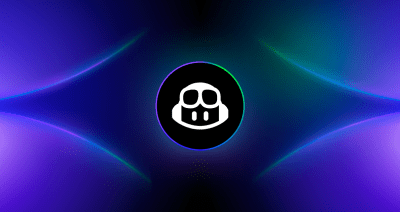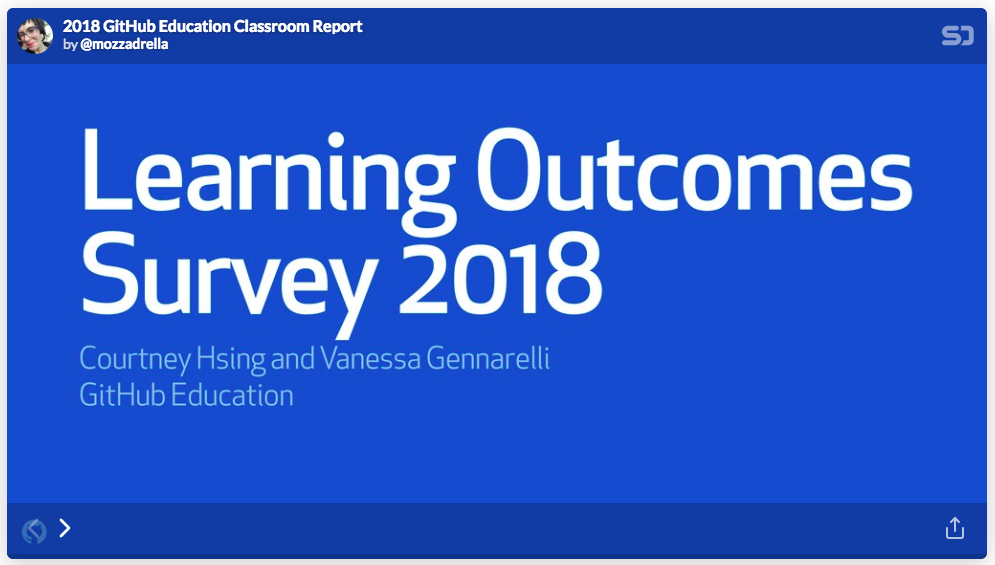GitHub Classroom report predicts positive student learning outcomes
See the results from a survey of 8,000 students and teachers.

As of July 2018, GitHub Education has helped over one million students learn to code. Teachers around the world use version control to help students collaborate on software, participate in open source communities, and automate administrative tasks. But what impact does using GitHub have on students? What do students learn by using GitHub?
Education General Manager @mozzadrella and I wanted to find out how using GitHub in the classroom shapes learning outcomes for the 2018 GitHub Education Classroom Report. We surveyed 8,000 students and teachers who had (and had not) used GitHub in the classroom. This post will give an overview and key takeaways.
Overall, we found that how classrooms used GitHub matters—and that students benefited from using GitHub in the classroom in a few important ways. Compared to students who didn’t use GitHub in their courses, students who did:
- Felt better prepared for their future careers
- Learned more about industry tools, collaboration, creating a portfolio, and project management
- Felt more connected to the developer community
- Felt a greater sense of belonging both in school and in the software industry
- Benefited more from teacher feedback received on GitHub
What are learning outcomes?
Think of learning outcomes as goals for students. The education field uses these goals to design curriculum and to assess what students know.
In our survey, we focused on these key areas: preparation for the future, classroom experiences, developing a sense of belonging, feedback, and the experience of learning to use GitHub.
Eight thousand students and teachers responded
We compared answers from respondents who used GitHub and those who did not use GitHub in the classroom. Generally, we looked at what the average respondent reported, so the findings may not apply to every classroom.
Positive learning outcomes
Using GitHub (versus not using GitHub) in programming classes predicted greater positive learning outcomes:
- Students felt more prepared to take part in the developer community: 31% of students who used GitHub in the classroom and 14% of students who didn’t use GitHub in the classroom felt their course prepared them for being a part of the developer community “very much”.
- Students felt more prepared for creating a portfolio of their work: 30% of students who used GitHub in the classroom and 15% of students who didn’t use GitHub in the classroom felt their course prepared them for developing a portfolio of their own work “very much”.
- Students felt they learned more about project management: 25% of students who used GitHub in the classroom and 12% of students who didn’t use GitHub in the classroom felt they had learned “very much” about project management.
- Students felt they learned more about popular industry tools: 29% of students who used GitHub in the classroom and 14% of students who didn’t use GitHub in the classroom felt they had learned “very much” about popular industry tools.
- Students felt more prepared for future internships or careers: 33% of students who used GitHub in the classroom and 19% of students who didn’t use GitHub in the classroom felt their course prepared them for future internships or careers “very much”.
- Students felt they learned more about teamwork and collaboration: 32% of students who used GitHub in the classroom and 17% of students who didn’t use GitHub in the classroom felt they had learned “very much” about teamwork and collaboration.
Sense of belonging
Using GitHub (versus not using GitHub) in programming classes predicted a greater sense of belonging, a variable important to academic success:
- 51% of students who used GitHub in the classroom and 37% of students who didn’t use GitHub in the classroom agreed or strongly agreed with statements indicating feelings of belonging in the classroom.
- 48% of students who used GitHub in the classroom and 37% of students who didn’t use GitHub in the classroom agreed or strongly agreed with statements indicating feelings of belonging in the field.
Feedback
Of the students who used GitHub in the classroom and received teacher feedback, those who received (versus did not receive) feedback via GitHub benefited more from teacher feedback.
Students felt they used their teachers’ feedback more effectively and found the feedback more helpful:
- 74% of students who received teacher feedback via GitHub and 67% of students who didn’t receive teacher feedback via GitHub agreed or strongly agreed they used the feedback effectively.
- 75% of students who received teacher feedback via GitHub and 65% of students who didn’t receive teacher feedback via GitHub agreed or strongly agreed the feedback was helpful.
Students felt their teachers were more aware of their needs as a student:
- 68% of students who received teacher feedback via GitHub and 60% of students who didn’t receive teacher feedback via GitHub agreed or strongly agreed the teacher understood their needs as a student.
Support in learning to use Git and GitHub
Students needed more support from teachers and peers when learning to use GitHub. About a quarter of students felt they received less support than they needed from teachers, and about a third of students felt they received less support than they needed from peers.
Implications for Computer Science education
@mozzadrella, who is also an instructional designer, sees important conclusions in the data around developing a sense of belonging and self-efficacy:
This study offers on-ramps to help more people succeed in Computer Science education. We now know that using GitHub in the classroom predicts a greater sense of belonging, which is related to persistence, overcoming obstacles, and overall academic success.
Feedback is a huge piece of learning, and students say feedback delivered through GitHub is both more effective and more helpful. Better feedback leads to better code. This is an urgent insight that will move the entire education field forward.
The last key insight is about student success: Students who use GitHub in their technical courses report being more prepared for future coursework and for work in industry. This has wide-ranging implications for student engagement in technical education.”
As the school year starts, teachers can use these insights to calibrate for the needs of students. Teachers who are looking for help getting up to speed on GitHub can use the online teacher training in Campus Advisors, or sign up to find out more about GitHub Education.
Thank you, GitHub Education
It was an exciting opportunity to conduct this study. As my background is in psychological research, I’m naturally curious about how different variables shape learning. The big questions we took on challenged me to put myself in the students’ shoes. And as a teacher myself, insight to the challenges students face and how resources may be leveraged to boost positive learning outcomes is incredibly valuable. Thank you to everyone who participated in our research. We look forward to sharing more research findings with you in the future.
Written by
Related posts

From pair to peer programmer: Our vision for agentic workflows in GitHub Copilot
AI agents in GitHub Copilot don’t just assist developers but actively solve problems through multi-step reasoning and execution. Here’s what that means.

GitHub Availability Report: May 2025
In May, we experienced three incidents that resulted in degraded performance across GitHub services.

GitHub Universe 2025: Here’s what’s in store at this year’s developer wonderland
Sharpen your skills, test out new tools, and connect with people who build like you.
